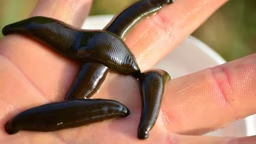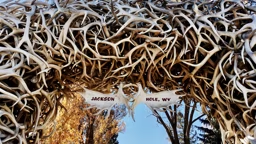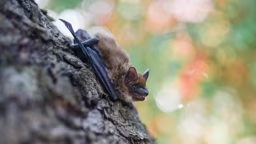It was an unusual symphony of rusty hinges and popping wings, punctuated by arrhythmic “ahonks” and “ahinks.”
The hard-driving V-formation following the contour of the river cruised right over my head as I was nearing the end of my morning run. It was early fall, and the temperature conditions were just right to amplify the sound and beat of the Canada geese’s creaky wings.
Hearing the labor of their wings made me realize that migrating at speeds of 30 to 60 mph from the northern half of the United States to distances as far away as Northern Mexico is truly a Herculean feat.
Spotting Canada geese, however, is not such an impressive feat. Canada geese may be some of the most recognizable of all birds with their sleek, grayish-brown body, and striking tuxedo-like markings.
And they seem to be everywhere these days, lounging around golf courses, populating urban parks and competing with plastic lawn ornaments across much of the northern United States. This familiar nuisance is the giant goose, a resident or non-migratory Canada goose.
But the giant goose is just one of 11 different subspecies of Canada geese in North America. Canada geese range in size from the small, cackling goose to the giant goose, weighing up to 20 pounds, with wings spanning up to six feet. Some head south in the fall and north in the spring, but not all of them migrate.
Giant goose. Resident geese are not simply migrant geese that have found their surroundings to be too cushy to migrate. Rather, they once lived in the prairies of North America and were an important commodity and source of food for Native Americans and early settlers. Wetland destruction and uncontrolled hunting decreased their population so dramatically that they were thought to be extinct until a flock of them was discovered in Minnesota in 1962.
Efforts to reintroduce the species were so successful that the population has swelled to the millions in less than 50 years. Giant Canada geese are highly adaptable animals that live for up to 25 years, breed earlier in life, and tend to lay larger clutches of eggs with lower mortality rates than their migratory counterparts.
On the move. Scientists have long puzzled over the complexity of migrating Canada geese. How do they endure their arduous journeys and navigate to the same breeding and wintering sites year after year?
North American Canada geese migrate to the South Atlantic, the Gulf Coast states, the Southwestern States and Mexico every fall when changes in weather and temperature signal it’s time to travel. Flying in family groups, they cruise at different altitudes depending on the weather and their intent. Typically, they fly at about 3,000 feet, but they may drop as low as 25 to 30 feet when searching for food or a resting place. To avoid inclement weather, they may soar as high as 9,000 feet.
Survival for migrating Canada geese is heavily dependent on being part of a group. Flying day and night in good weather and in bad, they honk back and forth to communicate and maintain their position.
They also fly in the characteristic V-formation for a reason: The leader, who is not necessarily the oldest or the strongest, breaks the resistance of the wind for the others, creating a draft in much the same way a boat hull creates a wake. Birds fly just to one side of the bird in front of them, and a rising air current makes the lift-up phase of their wing beating approximately 70 percent more efficient. The leader drops back in the formation when tired, and another goose moves to the front, enabling the flock to fly a thousand or more miles without resting.
The hard-driving V-formation following the contour of the river cruised right over my head as I was nearing the end of my morning run. It was early fall, and the temperature conditions were just right to amplify the sound and beat of the Canada geese’s creaky wings.
Hearing the labor of their wings made me realize that migrating at speeds of 30 to 60 mph from the northern half of the United States to distances as far away as Northern Mexico is truly a Herculean feat.
Spotting Canada geese, however, is not such an impressive feat. Canada geese may be some of the most recognizable of all birds with their sleek, grayish-brown body, and striking tuxedo-like markings.
And they seem to be everywhere these days, lounging around golf courses, populating urban parks and competing with plastic lawn ornaments across much of the northern United States. This familiar nuisance is the giant goose, a resident or non-migratory Canada goose.
But the giant goose is just one of 11 different subspecies of Canada geese in North America. Canada geese range in size from the small, cackling goose to the giant goose, weighing up to 20 pounds, with wings spanning up to six feet. Some head south in the fall and north in the spring, but not all of them migrate.
Giant goose. Resident geese are not simply migrant geese that have found their surroundings to be too cushy to migrate. Rather, they once lived in the prairies of North America and were an important commodity and source of food for Native Americans and early settlers. Wetland destruction and uncontrolled hunting decreased their population so dramatically that they were thought to be extinct until a flock of them was discovered in Minnesota in 1962.
Efforts to reintroduce the species were so successful that the population has swelled to the millions in less than 50 years. Giant Canada geese are highly adaptable animals that live for up to 25 years, breed earlier in life, and tend to lay larger clutches of eggs with lower mortality rates than their migratory counterparts.
On the move. Scientists have long puzzled over the complexity of migrating Canada geese. How do they endure their arduous journeys and navigate to the same breeding and wintering sites year after year?
North American Canada geese migrate to the South Atlantic, the Gulf Coast states, the Southwestern States and Mexico every fall when changes in weather and temperature signal it’s time to travel. Flying in family groups, they cruise at different altitudes depending on the weather and their intent. Typically, they fly at about 3,000 feet, but they may drop as low as 25 to 30 feet when searching for food or a resting place. To avoid inclement weather, they may soar as high as 9,000 feet.
Survival for migrating Canada geese is heavily dependent on being part of a group. Flying day and night in good weather and in bad, they honk back and forth to communicate and maintain their position.
They also fly in the characteristic V-formation for a reason: The leader, who is not necessarily the oldest or the strongest, breaks the resistance of the wind for the others, creating a draft in much the same way a boat hull creates a wake. Birds fly just to one side of the bird in front of them, and a rising air current makes the lift-up phase of their wing beating approximately 70 percent more efficient. The leader drops back in the formation when tired, and another goose moves to the front, enabling the flock to fly a thousand or more miles without resting.
Science: The eyes have it. Using radar and banding, scientists have studied the flight paths and navigational abilities of Canada geese. Although their navigation is still not fully understood, scientists believe that geese rely on a number of environmental cues. For migrating birds like geese, redundant cues are important since not all sources of orientation information are available all the time. In order to migrate during the day, at night, and above or under overcast skies, birds appear to use a cadre of cues, including landmarks, magnetic fields, solar orientation, celestial patterns, the prevailing wind direction, odor and sound.
One of the most interesting of these environmental cues is magnetism. Birds don’t respond to magnetic fields as a compass needle. Rather, they appear to have their own on-board GPS system that gives them visual feedback on the Earth’s magnetic fields through a magnetically sensitive chemical reaction thought to occur in the eyes of the birds.
Our relationship with Canada geese is highly paradoxical. The sound and sight of Canada geese flying overhead has long signaled the change of the seasons. But we watch migrating geese with awe while trying to shoo away their resident cousins. The reintroduction of the giant Canada goose has been one of wildlife management’s success stories. But the rapid increase in the resident Canada geese population, combined with a noticeable decrease in the migrating geese population, is creating a whole new set of wildlife management problems.
The resident geese are here to stay. Time will tell if the migratory geese will keep coming.
From her dock on Wellesley Island in the St. Lawrence River, Nancy Cain sees a lot of comings and goings, from ships to geese.
One of the most interesting of these environmental cues is magnetism. Birds don’t respond to magnetic fields as a compass needle. Rather, they appear to have their own on-board GPS system that gives them visual feedback on the Earth’s magnetic fields through a magnetically sensitive chemical reaction thought to occur in the eyes of the birds.
Our relationship with Canada geese is highly paradoxical. The sound and sight of Canada geese flying overhead has long signaled the change of the seasons. But we watch migrating geese with awe while trying to shoo away their resident cousins. The reintroduction of the giant Canada goose has been one of wildlife management’s success stories. But the rapid increase in the resident Canada geese population, combined with a noticeable decrease in the migrating geese population, is creating a whole new set of wildlife management problems.
The resident geese are here to stay. Time will tell if the migratory geese will keep coming.
From her dock on Wellesley Island in the St. Lawrence River, Nancy Cain sees a lot of comings and goings, from ships to geese.

 Brian M. Collins, www.imagesinnaturallight.com
Brian M. Collins, www.imagesinnaturallight.com 









